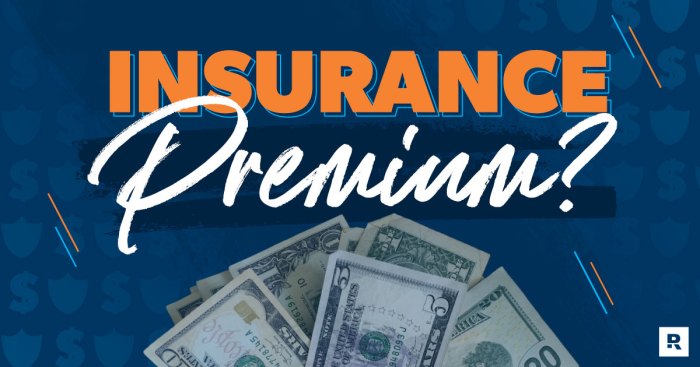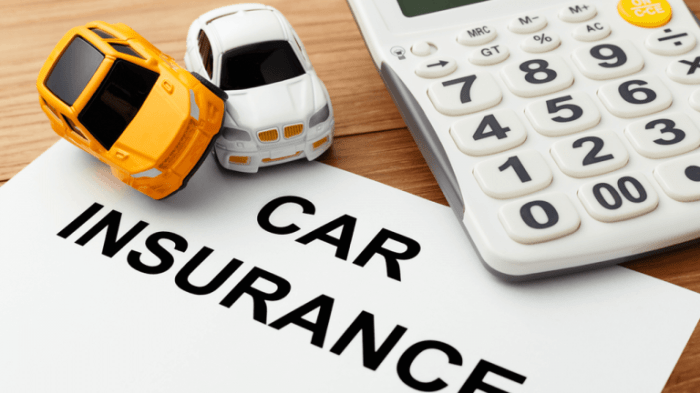Ever wondered how much that monthly car insurance bill actually represents? Understanding your car insurance premium is key to responsible car ownership. It’s more than just a number; it’s a reflection of your risk profile, the type of coverage you choose, and various other factors that insurance companies meticulously consider. This guide unravels the complexities of car insurance premiums, offering clarity and insights into this often-misunderstood aspect of driving.
From the fundamental components that make up your premium to the strategies for securing lower rates, we’ll explore the intricacies of car insurance pricing. We’ll delve into how your driving history, age, vehicle type, location, and even your credit score can influence the final cost. By the end, you’ll be equipped with the knowledge to navigate the world of car insurance with confidence and make informed decisions about your coverage.
Defining Car Insurance Premiums

Car insurance premiums are the amount you pay to an insurance company for coverage against financial losses related to car accidents or damage. Understanding how these premiums are calculated is crucial for making informed decisions about your insurance policy. This section will break down the key components and factors involved.
Components of a Car Insurance Premium
A car insurance premium is comprised of several key elements. These include the cost of the insurance coverage itself, administrative fees, and the insurer’s profit margin. The insurer uses sophisticated actuarial models to assess risk and determine the appropriate premium. This assessment considers a variety of factors, some of which are within the driver’s control, while others are not. The ultimate goal is to balance the cost of providing coverage with the revenue generated from premiums.
Factors Influencing Premium Calculation
Numerous factors influence the calculation of your car insurance premium. These factors are broadly categorized into driver-related factors, vehicle-related factors, and location-related factors. Driver-related factors include your driving history (accidents, tickets), age, and credit score. Vehicle-related factors encompass the make, model, year, and safety features of your car. Location-related factors involve your address, as crime rates and accident frequency in your area significantly impact risk assessment. Finally, the type of coverage you choose significantly impacts your premium.
Types of Car Insurance Coverage and Their Impact on Premiums
Different types of car insurance coverage offer varying levels of protection and, consequently, affect your premium. Liability coverage pays for damages caused to others in an accident. Collision coverage covers damage to your own vehicle in an accident, regardless of fault. Comprehensive coverage protects your vehicle against non-accident-related damage (e.g., theft, vandalism). Uninsured/underinsured motorist coverage protects you if you’re involved in an accident with an uninsured or underinsured driver. Adding more comprehensive coverage will naturally increase your premium, but it also provides greater financial protection.
Impact of Coverage Types on Premiums
| Coverage Type | Factors Affecting Premium | Typical Cost Range (Annual) | Example Scenarios |
|---|---|---|---|
| Liability | Driving record, location, coverage limits | $300 – $1000 | Higher limits increase cost; a clean driving record in a low-risk area will result in lower premiums. |
| Collision | Vehicle value, driving record, deductible amount | $300 – $1500 | A newer, more expensive car will cost more to insure; a higher deductible lowers the premium. |
| Comprehensive | Vehicle value, location, deductible amount | $200 – $800 | Living in a high-theft area will increase premiums; a higher deductible reduces cost. |
| Uninsured/Underinsured Motorist | Location, coverage limits | $100 – $500 | Higher coverage limits lead to higher premiums; areas with higher rates of uninsured drivers command higher premiums. |
Factors Affecting Premium Costs
Several interconnected factors influence the cost of your car insurance premium. Understanding these factors can help you make informed decisions to potentially lower your expenses. These factors are often assessed by insurance companies using sophisticated algorithms to calculate your individual risk profile.
Driving History
Your driving history is a primary determinant of your insurance premium. A clean driving record, free of accidents and traffic violations, typically results in lower premiums. Conversely, accidents, particularly those resulting in significant damage or injuries, and traffic violations like speeding tickets or DUIs, will significantly increase your premiums. Insurance companies view these incidents as indicators of higher risk, leading them to charge more to cover potential future claims. For example, a driver with three speeding tickets in the past year might see their premium increase by 20-30% compared to a driver with a spotless record. The severity and frequency of incidents directly correlate with premium increases.
Age and Gender
Statistically, age and gender are factors considered in premium calculations. Younger drivers, particularly those in their teens and early twenties, generally pay higher premiums due to their statistically higher accident rates. Insurance companies view this demographic as higher risk. Gender also plays a role, with historical data often showing differences in accident rates between men and women. However, it’s crucial to note that this is a complex issue, and regulations regarding gender-based pricing vary significantly by location and are subject to ongoing legal and social scrutiny. For instance, a 20-year-old male driver will likely pay substantially more than a 40-year-old female driver with the same driving history.
Vehicle Type and Safety Features
The type of vehicle you drive and its safety features significantly influence your insurance premium. Sports cars and high-performance vehicles are often associated with higher premiums due to their higher repair costs and greater potential for accidents. Conversely, vehicles with advanced safety features, such as anti-lock brakes, airbags, and electronic stability control, may qualify for discounts. For example, a new SUV equipped with advanced driver-assistance systems will likely have a lower premium than a used sports car with minimal safety features, even if both vehicles are of similar value. The cost to repair or replace the vehicle is a key factor in determining premiums.
Location
Your location plays a critical role in determining your insurance premium. Areas with high crime rates, frequent accidents, and higher rates of vehicle theft generally have higher insurance premiums. This is because insurance companies anticipate a greater likelihood of claims in these areas. For example, a driver residing in a densely populated urban area with a high accident rate will likely pay more than a driver in a rural area with a lower accident rate. Insurance companies use geographic data to assess risk and adjust premiums accordingly.
Credit Score
In many jurisdictions, your credit score can influence your car insurance premium. A lower credit score is often associated with a higher risk of insurance claims, leading to higher premiums. The rationale behind this is that individuals with poor credit management may also exhibit less responsible behavior in other areas, including driving. This is a controversial practice, however, with some arguing that it unfairly penalizes individuals with low credit scores who may be otherwise safe drivers. For example, a driver with an excellent credit score might receive a discount of 10-15% compared to a driver with a poor credit score, even if their driving records are identical. The exact impact of credit score varies by state and insurance company.
Discounts and Savings on Car Insurance

Securing affordable car insurance is a priority for most drivers. Fortunately, many insurance companies offer a variety of discounts to help lower your premium costs. Understanding these discounts and employing effective strategies for comparison shopping can significantly reduce your annual expenditure. This section will explore common discounts and methods for obtaining the most competitive rates.
Common Car Insurance Discounts
Numerous discounts are available to reduce your car insurance premium. These incentives reward safe driving habits, responsible vehicle ownership, and smart financial choices. Taking advantage of these discounts can lead to substantial savings over the life of your policy.
- Safe Driving Discounts: Many insurers offer discounts for drivers with clean driving records, demonstrating a history of safe driving practices. These often involve a period of accident-free driving, sometimes coupled with successful completion of defensive driving courses. The specific requirements and discount percentages vary widely depending on the insurer and your driving history.
- Bundling Discounts: Insurers frequently provide discounts for bundling multiple insurance policies, such as combining car insurance with homeowners or renters insurance. This practice simplifies the insurer’s administrative process and often results in significant savings for the policyholder.
- Good Student Discounts: Students who maintain a certain grade point average (GPA) may qualify for discounts, reflecting the lower risk associated with responsible, academically successful young drivers.
- Vehicle Safety Features Discount: Cars equipped with advanced safety features, such as anti-lock brakes (ABS), airbags, and electronic stability control (ESC), are often associated with lower accident rates, resulting in discounts for owners.
- Anti-theft Device Discount: Installing anti-theft devices, such as alarms or tracking systems, can deter theft and reduce the insurer’s risk, leading to lower premiums.
- Multi-car Discount: Insuring multiple vehicles under a single policy with the same insurer often results in a discount reflecting the insurer’s reduced administrative costs and the reduced risk associated with insuring multiple vehicles from the same household.
- Payment Plan Discounts: Some insurers offer discounts for paying your premiums annually in full, rather than opting for monthly installments.
Strategies for Securing Lower Premiums
Beyond utilizing available discounts, proactive strategies can help you secure lower premiums. Careful comparison shopping and maintaining a strong driving record are key components of this approach.
- Compare Quotes from Multiple Insurers: Obtaining quotes from several insurance companies allows you to compare prices and coverage options to find the most suitable and affordable policy. Online comparison tools can streamline this process.
- Maintain a Clean Driving Record: Avoiding accidents and traffic violations is crucial. A clean driving record significantly impacts your premium, demonstrating your lower risk profile to insurers.
- Shop Around Regularly: Insurance rates can fluctuate, so it’s advisable to periodically compare quotes from different insurers to ensure you are receiving the most competitive rate. Your circumstances, such as changes in your vehicle or driving habits, may affect your eligibility for different discounts over time.
- Consider Increasing Your Deductible: A higher deductible, the amount you pay out-of-pocket before insurance coverage kicks in, usually results in a lower premium. However, carefully assess your financial capacity to handle a higher deductible in case of an accident.
Comparing Quotes from Multiple Insurers
Effectively comparing quotes requires a structured approach. Consider the following:
- Use Online Comparison Tools: Many websites allow you to input your information once and receive quotes from multiple insurers simultaneously, simplifying the comparison process.
- Focus on Coverage, Not Just Price: While price is important, ensure that the coverage offered meets your needs. A lower price with inadequate coverage might ultimately prove more costly in the event of an accident.
- Read the Fine Print: Carefully review the policy documents from each insurer to understand the specific terms, conditions, and exclusions.
- Check Customer Reviews and Ratings: Research the insurers you are considering to gauge their reputation for customer service and claims handling.
Illustrative Examples of Premium Calculations

Understanding how car insurance premiums are calculated can seem complex, but breaking down the process reveals a logical system based on risk assessment. This section provides a detailed example to illustrate the factors involved.
Let’s consider a hypothetical driver, Sarah, a 30-year-old female living in a suburban area with a clean driving record. She drives a 2020 Honda Civic, uses her car for commuting, and has chosen a liability-only policy with a $500,000 liability limit.
Premium Calculation for a Hypothetical Driver
Several factors influence Sarah’s premium. Her age (30) places her in a lower-risk category than younger drivers. Her clean driving record further reduces her risk profile. The type of car she drives (a Honda Civic) is considered relatively safe and thus impacts the cost of repairs. Her location (suburban) is generally associated with lower accident rates than urban areas. Finally, the type of coverage she selected (liability-only) is the most basic and therefore the least expensive. Each of these factors contributes to the final premium calculation.
Let’s assume the base premium for a liability-only policy in Sarah’s area is $500 annually. Her age and clean driving record earn her a 20% discount, reducing the base premium to $400. The type of car she drives results in a further 5% discount, bringing the premium down to $380. Her suburban location provides an additional 10% discount, resulting in a final premium of $342.
Visual Representation of Premium Breakdown
Imagine a pie chart. The largest slice, representing approximately 60%, shows the base premium cost, reflecting the general cost of insurance in her area and the type of coverage. A smaller slice, about 20%, represents the discount earned due to her clean driving record and age. Another slice, about 10%, illustrates the discount for her vehicle type. The final slice, about 10%, depicts the discount received for her location. The sum of all slices equals the final premium of $342.
Impact of Different Factors on Premium Cost
To illustrate how changing factors influence the premium, let’s consider some scenarios. If Sarah had a speeding ticket on her record, her discount for a clean driving record would be significantly reduced or eliminated, increasing her premium. If she lived in a high-crime urban area, her premium would likely increase due to a higher risk of accidents and theft. Choosing comprehensive coverage, which includes collision and comprehensive coverage, would significantly increase her premium compared to her current liability-only policy. Switching to a higher-performance vehicle would also result in a higher premium due to increased repair costs and higher likelihood of accidents.
These examples demonstrate the interconnectedness of various factors in determining car insurance premiums. Insurers use sophisticated algorithms to assess risk and calculate premiums based on a multitude of variables, making each policy unique to the individual driver.
Ending Remarks
Ultimately, understanding what constitutes your car insurance premium empowers you to be a more informed consumer. By carefully considering the factors that influence your premium, actively seeking discounts, and comparing quotes from multiple insurers, you can secure the best possible coverage at a price that fits your budget. Remember, your car insurance premium is a dynamic figure, influenced by various elements throughout your policy’s lifespan. Regular review and comparison shopping are vital to ensuring you’re always getting the best value for your money.
FAQ Explained
What happens if I don’t pay my car insurance premium?
Failure to pay your premium can lead to policy cancellation, leaving you without coverage and potentially facing legal consequences if involved in an accident.
Can I change my coverage after my policy starts?
Generally, yes, but changes may affect your premium. Contact your insurer to discuss modifications and any associated cost adjustments.
How often are car insurance premiums reviewed?
Premiums are typically reviewed annually, but some insurers may adjust rates more frequently based on driving records or other relevant factors.
What is the difference between liability and comprehensive coverage?
Liability coverage protects you against financial responsibility for damages or injuries caused to others. Comprehensive coverage protects your own vehicle against damage from non-collision events (e.g., theft, weather).